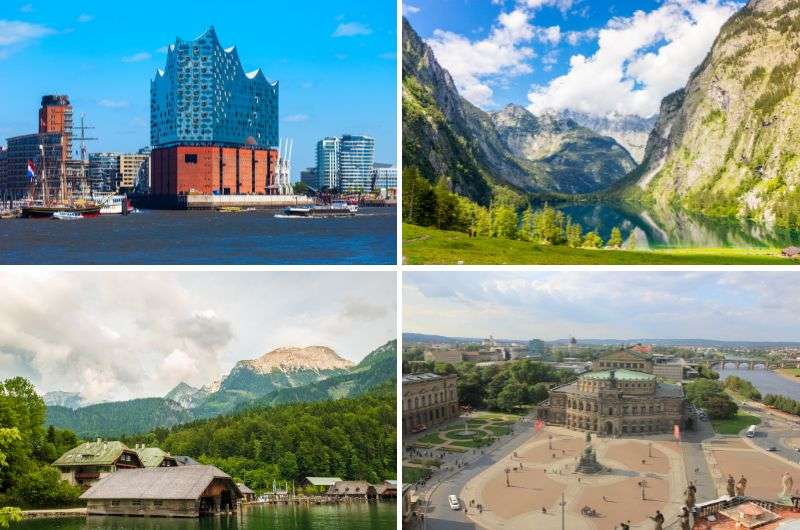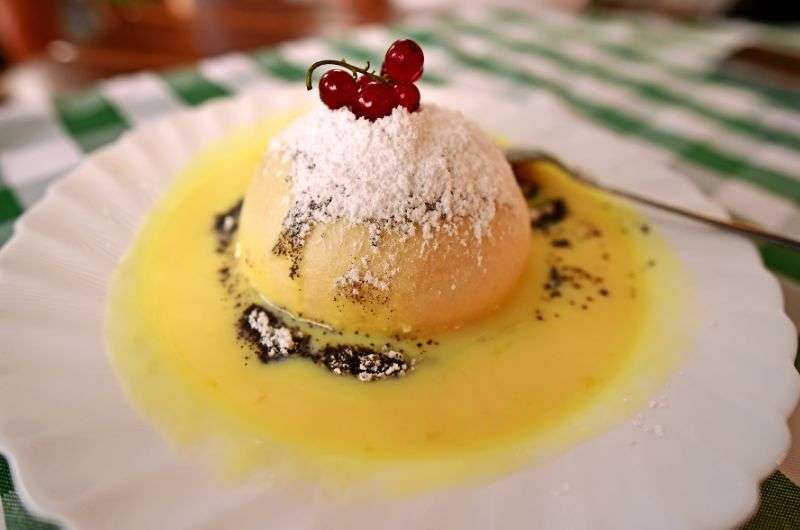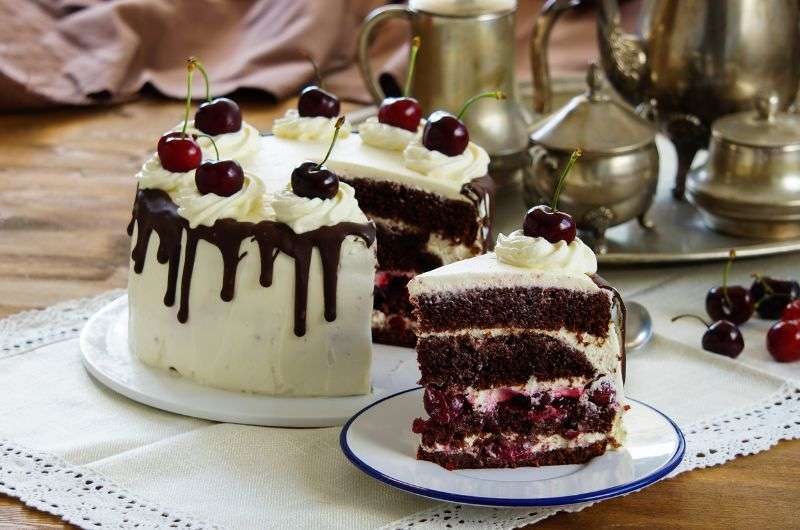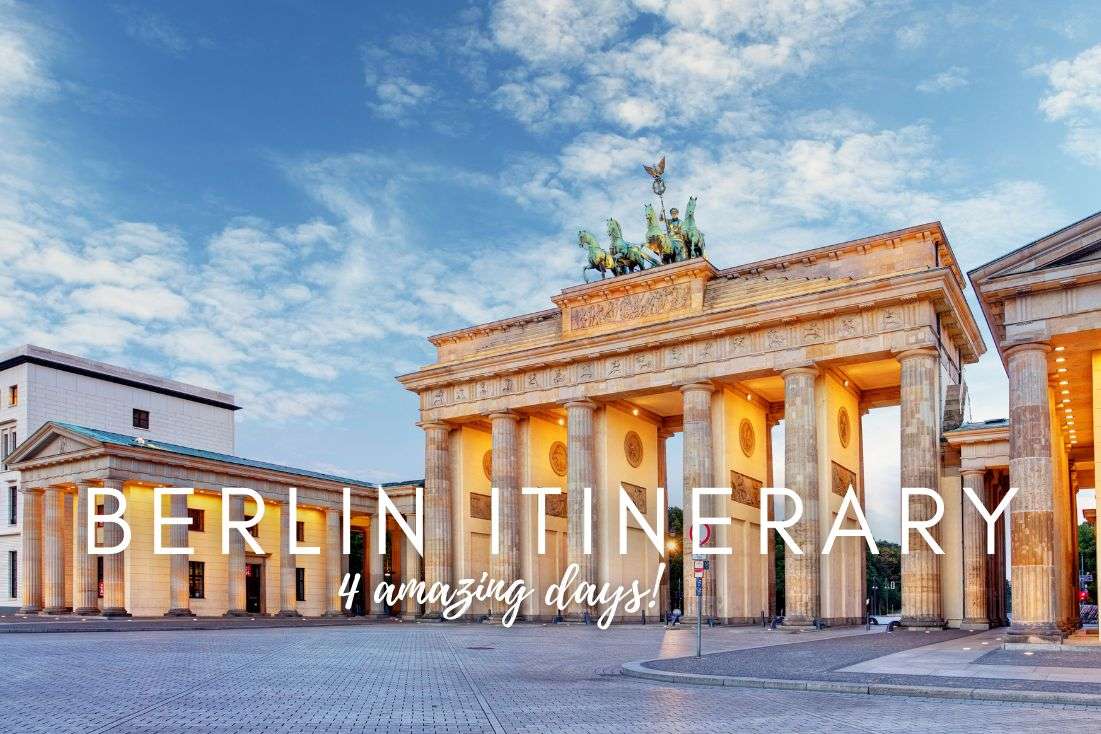24 Fun Facts about German Food and Drink Culture


They say that love goes through the stomach. While that might hold some truth, what I'm certain of is that getting to know a new culture goes through the stomach too. Food isn't just sustenance; it's a way to better understand customs, culture, and to some extent, the history of a country.
Germany is no exception. If you thought German cuisine was only about bratwurst and beer, you're mistaken. Germany spans 357,592 km² (137,983 mi²), making it the 62nd largest country globally and the 6th largest in Europe. It encompasses coasts, plains, highlands, and even the Alps in the south. But I won't bore you with geographical facts. I just wanted to convey that logically, German local cuisine is diverse and full of various flavors.
Moreover, Germany shares borders with nine other countries—Denmark, Poland, Czech Republic, Austria, Switzerland, France, Luxembourg, Belgium, and the Netherlands. This interconnectivity allows German culture and cuisine to blend with its neighboring nations. In the northern part of the country along the Baltic and North Sea, you'll find seafood and elements of Scandinavian cuisine. Meanwhile, the southern part of Germany bears elements of Austrian and Swiss cuisine. The western region is influenced by French cuisine. In short, there are numerous influences, but I don't know anyone who can resist German cuisine.

This is Germany!
So, if you're planning a trip to Germany, besides historical landmarks and beautiful landscapes, I highly recommend trying everything the local cuisine offers. And there's plenty on the menu. Let me tell you what's worth it and, most importantly, where to find it. Here are 23 facts about German food and drink that'll come in handy.
You might also be interested in reading:
- 5 Reasons Why You Have to Visit Hitler’s Eagle’s Nest
- One Week in Bavaria Itinerary—An Ultimate Guide
- Top 7 Sights of Salzburg
- 14 Unique Things to Do in Hamburg
Good to know before you go on a food marathon in Germany
To start, it's good to clarify a few basic characteristics of German cuisine and my observations. Because, well, the following points could even deter you so much that you decide not to taste anything at all in Germany (just kidding, that won’t happen)!
1. What do Germans eat?

If you're trying to lose weight, Germany is not the place to do it
I can't help but warn you: If you're on a diet and trying hard to shed a few pounds, Germany isn't the right destination. Local cuisine is delightful, but definitely not diet-friendly. And if you're there to enjoy everything to the fullest, you'll definitely encounter a few calorie bombs. Lots of meat, lots of dumplings and sauces.
2. Vegetarians might go hungry
Alright, I'm exaggerating a bit. But the fact is, the foundation of German cuisine is meat—pork, duck, beef, just meat. Sure, globalization is powerful, and in big cities, you'll find plenty of international cuisines, from Italian restaurants to Turkish kebabs. But then, we can't talk about traditional German dishes.
The paradox is that in Germany, a whopping 8–9% of the population are vegetarians, which is roughly 7 million people. After Italy, it's the country with the highest percentage of vegetarians. Fascinating. Perhaps they've had their fill of all that meat.
3. I hope you speak German

Enjoying German cuisine in Berchtesgaden. Apparently, I was dreaming of Africa—hence the t-shirt
If you head to major cities like Hamburg (by the way, I recommend it; here are 14 things to experience in this cool city), many restaurants will have menus in English and not just German.
However, if you're heading to smaller villages and have to order in German only, I wish you good luck. German is known for its compound words. What does that mean? Well, they take two or three long German words and make them into one endlessly long, utterly unmemorable term. Just so you know I'm not exaggerating, here are a few examples:
"Nahrungsmittelunverträglichkeit" means food intolerance. Frankly, I hope you don't have any allergies and won't have to pronounce this combination. I'm starting to get allergic just trying to read it.
Do you know how to say "cherry jam" or "pork chop"? It's "Sauerkirschmarmelade" and "Schweinefleischkotelett." Isn’t German a beautiful language?
Mealtimes in Germany
It’s not just about what they eat, but also about when they eat it.
4. How many meals are there in a German’s day?
Let's ask a fundamental question: Do Germans eat three meals a day? The answer is, not really. Apart from the basic meals like breakfast, lunch, and dinner, they often add a "second breakfast" (zweites Frühstück) and an afternoon snack (Kaffee und Kuchen). A meal is never too far away in Germany.
5. Enjoy a typical German breakfast (das Frühstück)

Good morning from Elbphilharmony in Hamburg!
A typical German breakfast is a continental-style breakfast with German elements. It typically consists of bread and other baked goods (Germans are bread and pastry lovers, but more on that later), often served with butter, jam, honey, or cheese. It will also include cheeses, boiled eggs, and even sausages.
Yogurt with müsli is also a common German breakfast. As the spelling suggests, the origin of müsli might be from these parts. The first version of müsli, namely oat flakes and apples, was "invented" by Dr. Maxmilian Bircher-Benner in 1900 in Switzerland. However, I'm not a fan of sweet breakfasts, so for me, bread, eggs, and cheese are the ideal option.
6. Lunch (das Mittagessen) is the meal of the day

Lunch and art at the Kunsthalle in Hamburg
Typically, lunch in Germany is the main meal of the day and often the only warm meal. Lunchtime is usually between 12–2 pm. In the past, people and children used to return home for lunch from work and school, by that I mean in the 1980s.
Today, we live in a different time, and the tradition of shared family lunches has declined. Quickly grabbing something to eat and rushing back to work is the new tradition, especially in major cities. You gotta love capitalism (I do)!
Speaking of quick bites for lunch, make sure to try Metropolis Urban Bistro in Dresden. It's a nice bistro with a beautiful design where you can grab a sandwich or hotdog. Not that you'd have to go to Dresden just for this place. I mean more like when you're already there, exploring all 13 places from my list.
7. Do you have a sweet tooth? Then you will love this tradition

This is the delicious German strudel!
Afternoon "Kaffee und Kuchen" or “coffee and cake” is a beloved tradition among all Germans. It's the perfect occasion for a get-together with friends or family. German cakes and desserts are a chapter in themselves (literally, see below).
8. Dinner is just another breakfast (das Abendessen)

Guten Abend!
Do you know why lunch is the main German meal of the day? Because dinner isn't worth much. Besides "Abendessen," dinner is also called "Abendbrot" or “evening bread”. A typical German dinner is cold (just like Germans) and light (unlike Germans), both in preparation and digestion. Classically, it's bread and something with it, like cheese or ham; during winter months, soup is also typical for dinner.
The exception is when you go to a restaurant. There, of course, they'll offer you much more than just soup and bread.
My favorite hotels in Germany (because after eating comes sleeping)
I know you’re all about food today, but I thought I’d have your back on another basic human need, too: sleep. Here are the German hotels that I’ve stayed at, loved, and now can’t stop dreaming about:
- Hotel Volksschule in Hamburg
- Almhotel Grünsteinblick near Berchtesgaden
- mightyTwice Hotel in Dresden
- Small Luxury Hotel Goldgasse in Salzburg
- Hyperion Hotel in Garmisch Partenkirchen
German food you need to try before you die

Not only do you have to experience the natural beauty of Germany, but German traditional food is also not to be missed!
Here are a few dishes you absolutely must try when visiting Germany to enjoy your experience to the fullest. Pun intended.
I recommend grabbing something to eat before reading further because if you you aren't hungry now, believe me, you'll soon start craving something.
9. Wurst is a must

Sausages are available on almost every corner in Germany
Germany is globally associated with sausages, and I'd say rightfully so. More than 1,000 types of sausages are produced in Germany each year, with approximately 881,000 tons of cooked meat products manufactured just in 2022. Boy, am I glad I’m not a German pig.
So, if you were to try just one thing, it should be a proper German sausage. You don't have to hunt them down at markets or outdoor festivals; wurst can be easily found in almost every restaurant in Germany. However, not every place offers the best.
For example, at the Hamburger DOM fair, don't go for the wurst. Trust me, you'll have trouble keeping it down while enjoying the attractions. It's possible, though, to taste several (hundred) wursts at DOM! Among the most well-known are weisswurst (white sausage), currywurst (sausage with curry flavor), and bratwurst (typical pork sausage).
The city of Nuremberg is famous for its typical Nürnberger Bratwurst, with a tradition spanning over 500 years. So, once you read about the '10 must-see places and more' and decide to visit, be sure to try one. For me, the best restaurant to visit is Bratwursthäusle near St. Sebald Church, where you can relish not only local specialties but also Tucher draft beer on the terrace.
Tip: We found the best value for money at the Park Plaza Hotel in Nuremberg.
10. One-pot dish or Eintopf

Eintopf aka what the house gave
Eintopf is a German national dish and one of the oldest traditional dishes in Europe. However, what exactly goes into Eintopf, nobody will tell you. In the 19th and 20th centuries, a similar way of preparing meals was typical, where everything was cooked together. One-pot dishes were common even in the German army during the Franco-Prussian War and World War I. But the term 'Eintopf' itself first appeared in 1934.
I suspect some German cleverness behind it. Isn't it brilliant? Throw in everything you find at home—legumes, meat, vegetables—into one pot, cook it until it becomes a thick soup, and call it a traditional national dish? Work smarter, not harder!
Note: Eintopf is not commonly found in German restaurants, you’ll need to become friends with a German grandma for the best ones!
11. Schnitzel is a traditional Bavarian dish

You have to order schnitzel at least once while you’re in Germany!
As most of you probably know, I'm from the Czech Republic, so schnitzel is not unfamiliar to me, and I can have it almost any time I want (except when I'm traveling through Turkey; pork schnitzel might not excite them there). But still, I couldn't resist having it in Germany, and what can I say? A good schnitzel never disappoints.
They say beer and schnitzel are the bread and butter of Bavarian cuisine. So, while exploring Berchtesgaden, traversing the local Alps, and delving into the rich history associated with Hitler, we also tried a few local restaurants.
I'd recommend a restaurant (also recommended to me by someone) where you simply have to have their schnitzel... or actually anything else; everything there is excellent! It’s called Holzkäfer. We tried the restaurant, and it was a meal to remember. I guess I’m not the only person thinking they’re wonderful, because without a reservation, you have no chance of getting in.
Tip: Here are a few other restaurants we had the chance to try in Bavaria and which I can wholeheartedly recommend: Bratwurst Röslein and Machhörndl Kaffee. These two restaurants are in Nuremberg. In Regensburg, among others, we tried restaurants like Storstad and Gashaus Hummel, both excellent and a kind of fine dining experience.
12. Good bread in Germany is a basic human right

Germans love bread!
I mentioned we'd talk about bread, and here it is now: Germans absolutely adore bread and baked goods. They have it at any time during the day, several times a day. According to statistics in 2022, approximately 5.1 million tons of bread and rolls were produced in Germany.
You'll find a bakery on every corner in Germany, and there are even two bread museums (Brotmuseum)—one in Ulm and the other in Ebergötzen. Personally, I enjoy a good slice of bread, but browsing through showcases exhibiting various types of bread is something I'd gladly skip. If you go, though, please let me know if I missed the museum of a lifetime.
13. Dumplings for everybody

Dumplings in Germany are always a good idea!
As I mentioned, bread is the foundation of German cuisine, and another food known and loved throughout the country is dumplings. In the north, they call them Klöße, and in the south, Knödel. Whether they are meat-filled, round, conical, sweet, as a side, or a main course... what matters is they are dumplings. Now I wonder, are Germans somehow obsessed with flour?
Story time: If you ever happen to head to Adolf Hitler's mountain retreat, the Eagle's Nest, let me give you some good advice, or rather, I mostly want to vent. We hiked all the way up (on our own legs, not using the bus like other lazy tourists), and the only light at the end of the tunnel for us was the delicious Bavarian dumplings at the Eagle’s Nest restaurant. Seriously, just imagine it: the path was steep, we were hungry and thirsty. When we finally entered the restaurant, ready to order two portions each straight away, we found out they didn't accept cards. “Nein” was all we got, no dumplings. We had a very silent, pouty trip down. So, my advice is: carry cash (and also, stay at Almhotel Grünsteinblick; the pool and breakfast somewhat made up for the dumpling mishap).
Food festivals and celebrations
In Germany, practically every celebration is an opportunity to enjoy some good food. Among the two biggest festivals associated with food and drink are Christmas and, especially, Oktoberfest.
14. Feasting during Christmas

Lots of people flock to Germany for the markets and Christmas atmosphere
What’s Christmas like, especially in terms of food, in Germany? Honestly, even the Germans can’t agree amongst each other. For instance, in the north, Christmas gifts are brought by Weinachstmann (an old man), and in the south, Christkind (Baby Jesus) brings presents to children. And what does a traditional German Christmas Eve dinner look like?
Do you know what the traditional German Christmas food served on Christmas Eve is (the main Christmas celebrations are on Christmas Even, not Christmas Day)? Duck, baked to crispy perfection, bathed in fat, served with potato dumplings and cabbage. Yum.
But you don't have to wait until Christmas to indulge in this heavenly goodness. You can have duck any time during the year. Where? I'll repeat myself, but I had the best duck in Holzkäfer (I swear) and paired with the beer they brew at that restaurant, it's heaven on Earth.

Kartoffelsalat
Kartoffelsalat, or potato salad, is another dish that ever goes missing from the Christmas table. It's similar to the Czech Republic: every family has its own recipe. Some add pickles, some add bacon. Some would start a family feud if you didn’t add pickle or bacon. The only thing everyone agrees on is potatoes.
What are typical German Christmas desserts? It probably won't surprise you that among the typical Christmas dishes are also special 'Christmas bread' or Stollen, traditionally filled with nuts, candied fruits (yuck), and sprinkled with heaps of sugar. Another sweet treat that shouldn't be missing are gingerbread cookies (Lebkuchen). You know what I’m talking about, right? Just like the cookie with icing in Shrek.
15. Oktoberfest takes place mainly in September

Oktoberfest feast as everyone knows it
What to expect from Oktoberfest? When you hear Oktoberfest, you probably imagine busty girls in traditional dresses, holding several half-liter beers in each hand. And you wouldn’t be wrong. But I think only a few of you will know how and when this festival originated.
In 1810, specifically from October 12th to 17th, the wedding of Crown Prince Ludwig of Bavaria to Therese of Saxe-Hildburghausen took place on the Theresienwiese meadow. Their love must’ve been the real deal because they invited the entire city to celebrate. And because everyone thought that it was the party of the year, the festival was repeated annually. Just due to bad weather, Oktoberfest gradually moved to September. It typically lasts for 16 days and ends on the first Sunday of October.
And how did Oktoberfest, where horse races were originally part of the main festivities, turn into the world's largest beer festival? Somehow naturally, like when you go to a party and suddenly there’s a beer in your hand (I guess it’s a universal party language that spans centuries!). At the end of the 19th century, a beer revolution took place, and local brewers moved from small stalls to large tents. Thanks to this, even today, you can visit traditional Bavarian breweries and taste several types of famous German beers every year. Thank goodness for those two love birds that strated all this beer goodness!

Prost!
One typical Oktoberfest beer is 'Festbier', a beer brewed specifically for this occasion by Munich breweries (I haven't tasted it yet, but you should try it and let me know). Good beer comes with good food, so at Oktoberfest, you'll find traditional Bavarian dishes like various sausages, dumplings, pretzels, and more. Not to forget, there are also carousels, roller coasters, and other attractions; to me, the ideal combination to end up feeling nauseous.
Oktoberfest celebrations are held all over Germany, but the Big Daddy of them all is in Munich. If you're heading down there, make sure to make hotel reservations well in advance because you'll be joined by thousands of other beer-happy peeps.
Popular German desserts are not popular for me
German folks are the ultimate sweet lovers and consider themselves connoisseurs of desserts. German cakes and pastries are celebrated worldwide... That was the official intro, and now here's my take: There are a few gems there that taste pretty good. However, amidst the desserts, there's a load of candied fruit, marzipan, and some of them even have artificial coloring. Me no likey.
Here's what I think are the best German desserts:
16. Apfelstrudel is not from Germany

Apfelstrudel
Let's start with the absolute classic (at least for me and all us Czechs), and that's apple strudel. A crispy pastry filled with apples and cinnamon, ideally topped with whipped cream and served with vanilla ice cream. Hard to believe that this balanced, not-too-sweet dessert is German. And actually, it's not. Strudel comes from Austria (well, quite a few dishes that are popular in Germany originate elsewhere).
17. The messy pancake you will love

Kaiserschmarrn—a thick pancake torn into pieces
Germans are quite crafty. They can flip a pancake in a pan, and voilà, a traditional German dessert is born. Kaiserschmarrn or 'emperor's mess' is basically a thicker pancake torn into pieces, sprinkled with sugar and cinnamon, or drenched in vanilla sauce. This dessert is flawless, except for the fact that it also originates from Austria. I told you I'm not a fan of German sweet pastries and colorful puddings, but let me try a little harder and tell about something that’s actually German:
18. Schwarzwälder Kirschtorte, my ace up the sleeve

Schwarzwälder Kirschtorte—it tastes sooo good!
I'm telling you, your taste buds will experience euphoria with this dessert, even if you're not usually into sweet stuff. “Black Forest cake” is composed of chocolate sponge, whipped cream, and cherries or sour cherries. An absolutely genius combination and the best German chocolate dessert.
German traditional drinks
Of course, beer is one of them, but it's not the only thing Germans sip on, despite appearances. There's a whole array of other interesting (not always excellent) beverages in Germany. But yeah, beer’s big in Germany.
19. Beer runs in Germans' veins

Beer and Germany are an inseparable duo\
German culture is steeped in beer through and through. In the Middle Ages, German monks were skilled brewers, brewing the alcoholic drink in monasteries. Allegedly, beer served as a replacement for water, which wasn't always potable (imagine if that were the case today... though in Germany, you’d sometimes think it’s still true—they sure love their beer!).
In those days, it was all about homebrewing, and everyone could put anything they wanted into beer. It wasn't until 1516 that Duke William IV established clear rules for beer production in Bavaria. For someone to claim they made beer, they had to use only three ingredients: water, hops, and barley malt.
Even though Bavaria is a beer powerhouse within Germany, it's not the only region proud of its beer production. Each area has its traditional styles and recipes. For example, Cologne is known for its light and mild beer called Kölsch. In Düsseldorf, on the other hand, traditional brown beer, Altbier, is famous. And I could go on and on. Anyway, currently, there are more than 1300 breweries in Germany producing over 5,000 types of beer.
The million-dollar question is, where in Germany should you go for good beer? According to me, you'll find good beer in almost any restaurant. Personally, I can recommend a great restaurant in the center of Berchtesgaden, a few steps from the beautiful Berchtesgaden Castle. Gasthof Neuhaus is an ideal place to go with a friend (I was there with my girlfriend) for a beer or two (so, just one for me). If you happen to be in Berlin, try Maximilians Berlin. Not only will you find great beer there, but also traditional German delicacies.
20. German Glühwein comes in many variations

German Glühwein is available especially at Christmas\
Among other traditional alcoholic beverages is German Glühwein (mulled wine). The basis of this mood-lifting drink is usually a red wine (but you'll find white as well), cooked with spices and flavorings added to taste, like sugar, cinnamon, orange, and cloves. It’ll be a bit different every time you try it depending on who cooks it. It’s mostly a seasonal drink (it makes me want to go out and buy Christmas presents when I think of it!), but you can easily get it in all cooler months of the year.
21. Germans put apples not only in desserts but also in drinks

Apfelwein=wine and apples!
Let's stick with alcoholic drinks for a bit (it’s 5 o’clock somewhere in the world). Apfelwein is cider made from fermented apples. And no, it doesn't taste like those canned ciders from the store. True German cider is sour.
Another typical German non-alcoholic beverage (in case it really isn’t wine o’clock) is Apfelschorle. It's basically apple juice mixed with sparkling water.
22. The traditional German Christmas drink

Eierlikör smells like Christmas!
And lastly, definitely worth mentioning is Eierlikör, a traditional German egg liqueur. The main ingredients are egg yolks, powdered sugar, vanilla extract, cream, and rum, so you can probably imagine the taste. It's especially popular around Christmas, but that combo of sweet cookies and even sweeter egg liqueur, well, not my cup of tea.
Last but not least: a couple random German food facts
A few other facts that are good to know before you set out to explore the diverse flavors of Germany:
23. Is street food a thing in Germany?

The perfect German snack—a pretzel
Of course it is. Street food is actually quite popular in Germany, like Hamburg and Munich. Often, besides traditional German dishes, you'll find international cuisine there.
Bratwurst and currywurst are ideal street foods. Grilled sausage is typically chopped into pieces, served on a paper tray with ketchup and curry. You’ll smell them from a mile away, so just keep your nose peeled if wurst is what you’re after.
A pretzel is the perfect handheld snack. You can get it both at bakeries and street stalls.
You might be surprised that traditional street food also includes kebab. But I don't see any reason why I should opt for some imitation in Germany after tasting real Turkish kebab. It just doesn’t compare.
24. Hamburg is a German seafood hub

This dish is called Fischbrötchen
Just a reminder that Germany isn't just about pork and sausages, but particularly in the northern part, you'll find excellent fish and seafood. You could, for example, wake up early on a Sunday morning and head to Hamburg's waterfront for the fish market (I won’t, but you can).
I'll recommend a really great seafood restaurant in Hamburg: Restaurant Daniel Wischer is near the Rathaus Square. The food was amazing, the interior was lovely, and the atmosphere was great. I not only highly recommend putting this place on your Hamburg bucket list, but most importantly I recommend making a reservation in advance (it’s on a lot of bucket lists). Head over to my article about Hamburg to check out all the cool restaurants and unique things to do in the city.
And whatever you do, definitely stay in the school-turned-hotel, Hotel Volksschule, while you’re in town. I am not easily impressed, but I give it a 10/10.
This post contains affiliate links. I earn a small commission if you make bookings through my links, at no additional cost to you. This helps keep this blog free, thank you!










Comments | Thoughts? Give us a shout!